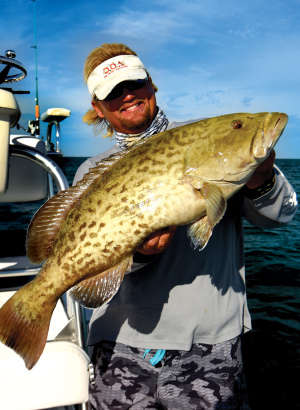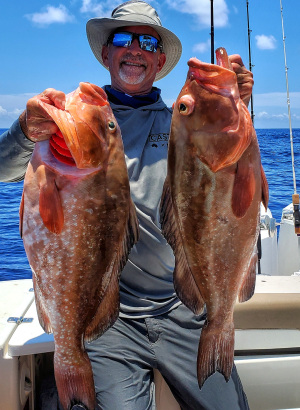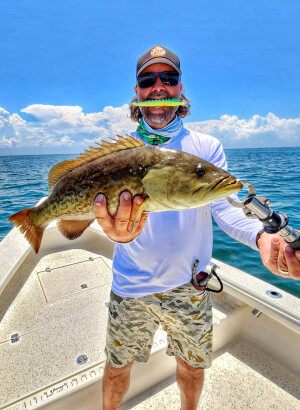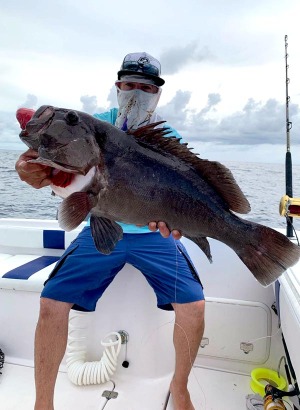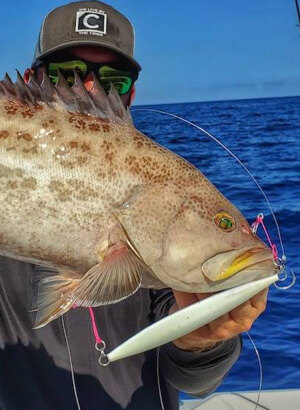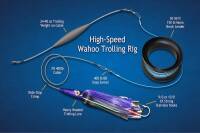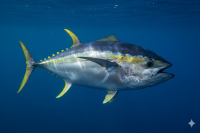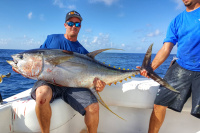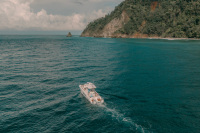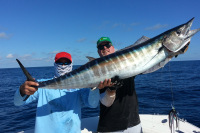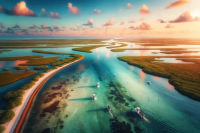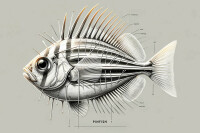June grouper fishing in Florida's Big Bend reaches peak season with Captain William Toney's proven cut bait techniques. Learn why cut bait outperforms live bait for gag grouper in warm water, plus essential tackle setups and timing strategies for consistent Big Bend grouper fishing success this summer.

Grouper Fishing Florida's Big Bend - Capt. William Toney
Grouper Fishing Florida's Gulf Coast
Florida grouper fishing reaches its peak in June when the season officially opens, and nowhere is this more evident than in the fertile waters of the Big Bend region. Captain William Toney, a seasoned expert with decades of experience in these waters, has developed proven techniques that consistently produce trophy gag grouper catches. His approach combines traditional knowledge with modern tactics, making him one of the most sought-after guides for grouper fishing in this unique ecosystem.
Why Florida's Big Bend Produces Trophy Gag Grouper
The Big Bend's limestone bottom structure creates the perfect habitat for gag grouper. This underwater topography features countless holes, ledges, and caves that grouper use for shelter and ambush points. The relatively shallow depths, combined with strong tidal currents, create a feeding environment that supports a robust forage base of pinfish, grunts, and other baitfish that grouper prefer.
Cut Bait vs Live Bait Grouper Fishing: The Science Behind the Strategy
Captain Toney's most fundamental principle centers on why cut bait works better than live bait in warm water conditions. This strategy defies conventional wisdom that live bait always outperforms cut bait, but the science supports his approach completely.
Even cutting the tail off of a pinfish will create more scent, attracting more grouper.
Capt. William ToneyBest Cut Bait for Gag Grouper
The most effective cut baits for Big Bend grouper fishing include:
- Mullet: High oil content creates extensive scent trails in warm water
- Pinfish: Local forage that grouper recognize immediately
- Lizard fish: Tough skin stays on hooks longer during strong currents
- Ladyfish: Oily flesh that disperses scent rapidly in warm conditions
Artificial Lures for Florida Grouper: Modern Techniques for Traditional Fish
While cut bait forms the foundation of Captain Toney's approach, grouper lures play an important role during specific conditions. Hot summer days when both air and water temperatures soar create opportunities for artificial presentations that can outperform natural baits.
MirrOlure grouper fishing techniques focus on scented soft plastics that combine the visual appeal of artificial lures with scent attraction. The MirrOlure LiL John series, when rigged properly, mimics wounded baitfish while releasing attractant scents that trigger grouper strikes.
These artificial presentations work best when:
- Water clarity exceeds 10 feet of visibility
- Current flow allows proper lure action
- Natural bait sources appear scattered or inactive
- Temperature conditions make cut bait handling difficult
Shallow Water Grouper Fishing Techniques: Maximizing Success in the Big Bend
Shallow water grouper fishing in the Big Bend requires different tactics than deep water offshore techniques. While keeper-sized gag grouper can be caught in as little as 12 feet of water, the most consistent action occurs in the 20-30 foot depth range where larger fish feel more secure.
Best Tackle for Florida Grouper: Equipment That Handles Big Bend Conditions
Grouper fishing rod and reel setups must balance sensitivity for detecting subtle bites with power for extracting fish from structure. Captain Toney recommends medium-heavy to heavy action rods in the 7-8 foot range, paired with reels capable of holding 300+ yards of 30-50 pound test line.
- Main line: 30-40 pound braided line for sensitivity and capacity
- Leader material: 50-80 pound fluorocarbon for abrasion resistance
- Leader length: 3-4 feet to prevent grouper from seeing the main line
- Connection: Quality swivel to prevent line twist in current
Best Hooks for Grouper: Circle Hooks and Sizing Strategy
Grouper baits require hooks that penetrate reliably while maintaining fish health for proper release. Circle hooks in sizes 6/0 to 10/0 provide the best combination of hookup ratio and fish survival rates. The self-setting action of circle hooks reduces gut-hooking incidents, which is crucial for maintaining healthy grouper populations.
Timing and Tidal Strategy for Maximum Success
Captain William Toney's grouper tips emphasize timing as the foundation of consistent success. High incoming tides, particularly during afternoon periods, create optimal feeding conditions. As tide pushes baitfish onto structure, grouper position themselves to ambush prey funneled by current flow.
Florida Grouper Regulations and Conservation
Current Florida regulations allow each angler to retain two gag grouper with a minimum size limit of 24 inches. Captains and crew members cannot harvest fish, ensuring that paying customers receive the benefit of any keeper fish caught. These regulations changed in 2023, making it essential to verify current rules through the Florida Fish and Wildlife Conservation Commission before each trip.
Proper handling techniques during catch and release ensure healthy fish populations for future generations:
- Use circle hooks to reduce internal injuries
- Minimize air exposure time for released fish
- Vent fish properly when brought up from depth
- Handle fish with wet hands or gloves to protect slime coat
- Release fish head-first into the water when possible
Weather and Seasonal Patterns
Summer grouper fishing in the Big Bend region requires adaptation to heat and afternoon thunderstorm patterns. Early morning trips often provide the most comfortable conditions, though afternoon fishing can be extremely productive when weather cooperates. Captain Toney notes that grouper continue feeding actively throughout hot days, unlike some species that become lethargic in high temperatures.
Finding Productive Grouper Structure
Successful grouper fishing requires understanding how to locate and fish productive bottom structure. Modern electronics make this process more efficient, but interpreting what the sonar shows remains an art form. Look for subtle bottom irregularities, isolated rocks, and areas where hard bottom meets sand or grass.
Captain Toney emphasizes that finding fish precedes catching fish. Spending time locating productive structure pays dividends throughout the fishing day. Mark productive spots with GPS coordinates for future reference, but always approach marked locations from different angles to avoid spooking fish.
Login
to leave a review.
User Reviews
There are no reviews yet.Complete Dredge Pulley Setup Guide
Saltwater
12.28.2020
High Speed Wahoo Trolling Rig
Saltwater
09.07.2018
Best Bait for Wahoo
Saltwater
12.30.2023
Pinfish - A Comprehensive Guide
Saltwater
11.10.2023
0

